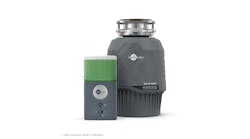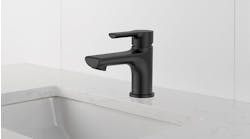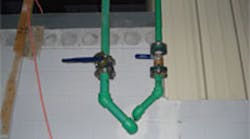Latest from Showers
Sponsored
UNION COUNTY, KY. — Lyons Co., Mechanical Contractors and Engineers, Glasgow, Ky., designed and installed a unique piping system for the River View Coal Mine facility here that supplies domestic water to two shower rooms, an integral part of the mine’s support buildings, measuring 22-sq.ft. x 24-sq.-ft. with 40 shower heads apiece.
Operated by River View Coal LLC, the River View Coal Mine is expected to produce 6.4 million tons of high-sulfur coal per year. Construction of the facility’s infrastructure has proceeded quickly. The mine is expected to employ as many as 600 workers by the end of 2010, according to company officials.
In summer 2008, when Lyons was preparing its bid, copper prices were at an all-time high. Tony Simmons, project superintendent for Lyons explained that the company had been investigating copper piping alternatives, including polypropylene.
Nick Kohnen, project manager for Lyons’ Glasgow office, had been introduced to Aquatherm by JD McQueen, outside sales representative with Ferguson Enterprises. Ferguson, Aquatherm’s Tennessee distributor, has been carrying Aquatherm since March 2008 and this was the Bowling Green, Ky., branch’s first polypropylene job.
"We’re finding that once customers use it they are completely sold on it,” said McQueen. “It’s a matter of their being open to what’s perceived here as a new technology, but it has really been established everywhere else for more than 30 years.”
While new to Lyons and relatively new to North America, polypropylene piping is actually anything but new — Aquatherm’s polypropylene piping systems have been used for 30-plus years in more than 70 countries. Aquatherm’s fusion welding process creates seamless connections while eliminating the need for toxic materials, glues, resins and open flames in piping installations.
The polypropylene pipe and desired fitting are simply inserted onto an Aquatherm welding device and heated for a specified time, typically only seconds, then joined together. Once fused, pipes and fittings have the same physical properties, eliminating systematic weaknesses. Additionally, a faser-composite layer in the pipe reduces linear expansion of the pipe by 75% compared to other plastics, ensuring that it hangs rigidly even when subjected to high operating temperatures (up to 200°F). Fully recyclable, Aquatherm Greenpipe reduces concerns about the cost and theft of copper, and is designed specifically for potable water applications.
Dennis Oliver, engineering manager at River View Coal, said that when Lyons presented Aquatherm as a cost saving option, he and his staff had no hesitation whatsoever.
“We knew how durable polypropylene is because we use HDPE in harsh environments and depend on it in the mines,” said Oliver. “It was a cost saving measure, and it made perfect sense for the shower rooms.”
The job could have been specced with copper, but PEX wouldn’t have been able to handle the high temperature ranges and other demands of the system, according to Simmons.
"The hot water is coming straight off the hot water boilers and the Aquatherm is able to carry the temperatures and the pressure,” said Simmons.
A learning curve
While the Aquatherm system forms extremely durable joints, there is a learning curve involved with it and proper training is essential to its durability. Local Ferguson and Aquatherm representatives hosted a four-hour fusion welding demonstration at the Lyons’ Glasgow office with Simmons and installer Joe Thomason in attendance. Simmons has been in the trade for about 30 years and had previous experience with HDPE and fusion pipe, but was a bit cynical of polypropylene at first.
“I was a bit skeptical of everything being in metric and it was a bit different,” said Simmons. “But it’s like a lot of things, you work with it a bit and you get used to it.”
In August 2008, Lyons rented an Aquatherm manual fusion welding jig for the 3-in. mains and a handheld fusion tool for the smaller welds. The main lines were three inches, with 2-in., 1½-in., 1-in. and ¾-in. Aquatherm Greenpipe, which wasalso used on the job. Aquatherm’s Greenpipe SDR 11, a version designed for cold water applications and without the fiberglass reinforcement layer was used to save further costs on cold water lines. The shower heads were installed along the outside walls of the rooms and a block of shower heads were also placed in the middle of the rooms.
Lyons used some copper in the chase plumbing walls in order to transition from the Aquatherm to the copper flush valves (Aquatherm is now working on introducing polypropylene adapters to the North American market), and Bradley stainless steel shower boxes, flush valves and urinals were installed, along with Kohler commodes.
Simmons and Thomason prefabricated some sections on the jobsite — mainly the headers that went around the outside of the shower rooms. They were prefabbed using Aquatherm’s fusion outlets and placed on stands, then hung in position for the shower boxes.
Simmons encountered some uncertainty in fastening and hanging some sections of pipe early on. However, Ferguson and Aquatherm quickly got representatives on the jobsite and provided direction and reassurance.
“I was a little frustrated with being sure that everything was done just right, but they got out here and got everything straightened out,” said Simmons. “A lot of the problem was that I was getting a bit too precise, or too technical.”
Regarding code approvals, the local inspector wasn’t familiar with Aquatherm, but upon reviewing a letter stating that the product was approved in the state in 2005 and knowing that it’s on the approved materials list, he was satisfied.
Aquatherm’s polypropylene pipe has a natural insulation value of R-1 or more depending on pipe dimension and SDR. However, the hot water mains throughout the building were insulated as a precaution to maintain water temperature because some the run outs to the showers were long and no reheat loop was included in the system.
Out of roughly 1,500 fusion connections, Lyons had only five leaks. A few of those resulted from overheating the pipe on the iron and the rest were on headers. Overall, Simmons was quite impressed with polypropylene’s reliability.
“Joe and I did all the work, and to have only five leaks, that’s pretty good,” said Simmons, adding that the number of leaks would certainly decrease further with more experience. “I’ve been using copper for 30 years, but there would have probably been that many leaks if we were using copper too.”
With roughly 3,000-ft. of Greenpipe installed in the facility, the shower rooms are now fully tested and operational, and the River View and Lyons staffs are quite satisfied.


